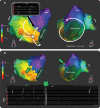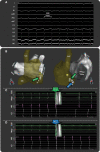Reversible Pulsed Electrical Fields as an In Vivo Tool to Study Cardiac Electrophysiology: The Advent of Pulsed Field Mapping
- PMID: 37727989
- PMCID: PMC10578517
- DOI: 10.1161/CIRCEP.123.012018
Reversible Pulsed Electrical Fields as an In Vivo Tool to Study Cardiac Electrophysiology: The Advent of Pulsed Field Mapping
Abstract
Background: During electrophysiological mapping of tachycardias, putative target sites are often only truly confirmed to be vital after observing the effect of ablation. This lack of mapping specificity potentiates inadvertent ablation of innocent cardiac tissue not relevant to the arrhythmia. But if myocardial excitability could be transiently suppressed at critical regions, their suitability as targets could be conclusively determined before delivering tissue-destructive ablation lesions. We studied whether reversible pulsed electric fields (PFREV) could transiently suppress electrical conduction, thereby providing a means to dissect tachycardia circuits in vivo.
Methods: PFREV energy was delivered from a 9-mm lattice-tip catheter to the atria of 12 swine and 9 patients, followed by serial electrogram assessments. The effects on electrical conduction were explored in 5 additional animals by applying PFREV to the atrioventricular node: 17 low-dose (PFREV-LOW) and 10 high-dose (PFREV-HIGH) applications. Finally, in 3 patients manifesting spontaneous tachycardias, PFREV was applied at putative critical sites.
Results: In animals, the immediate post-PFREV electrogram amplitudes diminished by 74%, followed by 78% recovery by 5 minutes. Similarly, in patients, a 69.9% amplitude reduction was followed by 84% recovery by 3 minutes. Histology revealed only minimal to no focal, superficial fibrosis. PFREV-LOW at the atrioventricular node resulted in transient PR prolongation and transient AV block in 59% and 6%, while PFREV-HIGH caused transient PR prolongation and transient AV block in 30% and 50%, respectively. The 3 tachycardia patients had atypical atrial flutters (n=2) and atrioventricular nodal reentrant tachycardia. PFREV at putative critical sites reproducibly terminated the tachycardias; ablation rendered the tachycardias noninducible and without recurrence during 1-year follow-up.
Conclusions: Reversible electroporation pulses can be applied to myocardial tissue to transiently block electrical conduction. This technique of pulsed field mapping may represent a novel electrophysiological tool to help identify the critical isthmus of tachycardia circuits.
Keywords: catheters; electroporation; follow-up studies; swine; transients and migrants.
Conflict of interest statement
Figures






Comment in
-
Learning Before Burning: Mapping With Reversible Pulsed Field Ablation.Circ Arrhythm Electrophysiol. 2024 Feb;17(2):e012430. doi: 10.1161/CIRCEP.123.012430. Epub 2024 Jan 29. Circ Arrhythm Electrophysiol. 2024. PMID: 38284234 No abstract available.
References
-
- Patel AM, d’Avila A, Neuzil P, Kim SJ, Mela T, Singh JP, Ruskin JN, Reddy VY. Atrial tachycardia after ablation of persistent atrial fibrillation: identification of the critical isthmus with a combination of multielectrode activation mapping and targeted entrainment mapping. Circ Arrhythmia Electrophysiol. 2008;1:14–22. doi: 10.1161/CIRCEP.107.748160 - PubMed
-
- Batista Napotnik T, Polajžer T, Miklavčič D. Cell death due to electroporation - a review. Bioelectrochemistry. 2021;141:107871. doi: 10.1016/j.bioelechem.2021.107871 - PubMed
-
- van Driel VJ, Neven K, van Wessel H, Vink A, Doevendans PA, Wittkampf FH. Low vulnerability of the right phrenic nerve to electroporation ablation. Heart Rhythm. 2015;12:1838–1844. doi: 10.1016/j.hrthm.2015.05.012 - PubMed
-
- Neven K, van Es R, van Driel V, van Wessel H, Fidder H, Vink A, Doevendans P, Wittkampf F. Acute and long-term effects of full-power electroporation ablation directly on the porcine esophagus. Circ Arrhythm Electrophysiol. 2017;10:e004672. doi: 10.1161/CIRCEP.116.004672 - PubMed
-
- Koruth J, Kuroki K, Iwasawa J, Enomoto Y, Viswanathan R, Brose R, Buck ED, Speltz M, Dukkipati SR, Reddy VY. Preclinical evaluation of pulsed field ablation: electrophysiological and histological assessment of thoracic vein isolation. Circ Arrhythm Electrophysiol. 2019;12:e007781. doi: 10.1161/CIRCEP.119.007781 - PMC - PubMed
Publication types
MeSH terms
LinkOut - more resources
Full Text Sources
Research Materials

